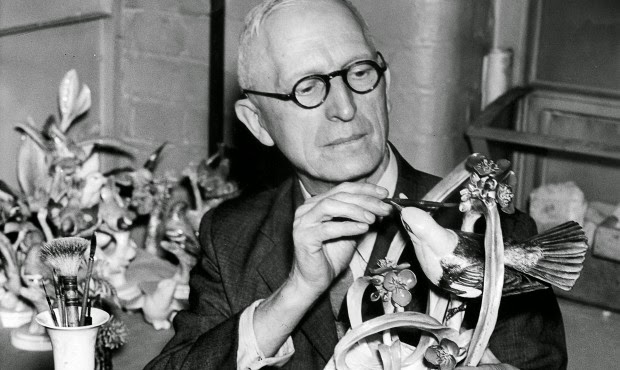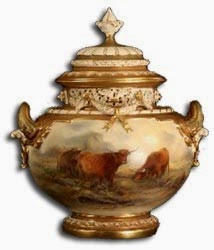Harry Davis
Harry Davis was born
in Worcester in 1885. His father, Alfred, was a china figure maker who worked
for Royal Worcester and his grandfather Josiah Davis was one of the most
talented gilders ever to work at the factory. Harry started out at St Peter’s
School (where the museum is now housed) then at the age of 13, started work for
Royal Worcester. Along with all the young boys he began doing very menial tasks
and was formally apprenticed for seven years under the talented landscape
artist, Ted Salter, on 3 November 1899.
Harry started work
under the wing of his grandfather, who taught him to draw. He also learned an
enormous amount from his tutor who taught the eager young boy to paint soft
misty landscapes in the style of Corot. Harry was deeply shocked when Salter
was killed, cycling over a level crossing, on his way to work in November 1902.
Ted Salter had
reinforced Harry’s love of the countryside and of fishing. A keen fisherman,
Harry was a follower of Isaac Walton, 17th century author of the
most successful angling book of all time, ‘The Compleat Angler’. He perfected
the difficult art of painting fish with amazing accuracy, possible only to
someone with a deep understanding of fish and their behaviour. Harry was an
active member of the Royal Worcester Fishing Club and later in life painted two
wonderful trophies for the club to present to competition winners each year.
Harry quickly proved
that he had tremendous natural ability and striking individuality. He was
always versatile and painted a large range of subjects with ease. Landscapes
with sheep, cattle, pigs, fish, snow scenes, London Scenes, polar bears,
palaces and gardens, but he was never a ‘Jack of all trades’ he would accept
nothing less than perfection in everything he did.
On the 4 July
1910 Harry married ‘Cissie’ (Ethel) Powell, a dressmaker, at St Peter’s church
that stood next to the Severn Street factory. A fine watercolour of cattle
drinking from a stream, given to the couple as a wedding present by their
friend Harry Stinton, is now in the museum collection.
Throughout the First
World War there was still demand for Harrys work, but in 1916 he volunteered
and joined the wireless section of the Royal Engineers. Harry’s abilities were
quickly utilised drawing diagrams for instruction purposes, but he also enjoyed
painting postcards which he sent to his friends. On the card showing a mountain
of equipment at St.Martin’s Gate Parade Ground (just up the road from the
porcelain factory) Harry was obviously tickled by the scene before him and
commented:
Not quite clear, But very near, Next
year?
In 1919 all Royal
Worcester employees who served for their country, including Harry Davis, were
presented with an urn with their name, department and dates of service
inscribed in gold.
In 1923 Royal
Worcester received a prestigious £7,000 order from His Highness Shri
Ranjitsinhji Vibhaji, Maharaja Jam Saheb of Nawanagar. The legendary Sussex and
England cricketer owned palaces in both India and England and wanted a service
to use in India illustrating his English estate and a set to use in England
decorated with scenes of his Indian home. Harry Davis was given the challenge
and designed and painted 24 of the most wonderful scenes. He worked from
photographs, yet created views full of light and atmosphere with intricate architectural
details that were widely admired.
Harry succeeded
William Hawkins as foreman of the ‘Men Painters’ department in 1928. He was
responsible for training many young apprentices and in the early 1930s to help
with his teaching, Harry produced several sets of etchings for decorative
plates, 12 castles, 12 cottages and 12 cathedrals. The scenes were expertly
etched onto copper plates and then printed as an outline onto the china. Many
artists in the department ‘filled in’ the colours over the printed designs
adding their signature to the finished work. Sometimes Harry himself did some
of the filling in, signing himself H SIVAD, Davis backwards! Later Harry also
etched some wonderful coaching subjects and some of his favourite fish.
Joyce Holloway remembers
Harry being so patient teaching the girls to paint:
When orders were scarce during the
Depressions, and because if you were under 16 you cocouldn't claim the dole,
workers were retained and little jobs were found for them. Harry Davis gave
painting lessons to girls to fill in the time… he was very patient and he
showed me one or two little ways in drawing …and he was a very nice person [his
skills] they seemed to me incredible, they still do.
Over the years Harry
completed some very prestigious commissions for special customers. In 1928 he
collaborated with his friend Harry Stinton to complete an important order for
Mr Kellogg the American Cornflake King. Harry Stinton painted a dinner service
of 25 service plates with magical snow scenes, with rich raised gilding on a
ruby ground, and Harry Davis painted a matching dessert service of 25 smaller
plates and 25 coffee cups and saucers with delicate Corot style landscapes.
In 1937 Davis painted
some exquisite panels on the silver-gilt casket presented to Charles William
Dyson Perrins when he was given the Freedom of the City of Worcester. The
following year Harry painted a stunning vase for the Australian cricketer, Sir
Donald Bradman to commemorate his three double centuries on the New Road Ground
at Worcester and in his book ‘Farewell to Cricket’ The Don wrote
It showed the field of play, the
spectators, the lovely trees along the river bank and dominating the whole
scene the architectural masterpiece, Worcester Cathedral. This is one of my
most treasured possessions.
In 1950 Harry teamed
up with his friend Ivor Williams, the Master Gilder, to produce a jardinière to
present to Sir Winston Churchill.
Harry’s talents did
not end there. He was also responsible for the design of a number of very
successful tableware patterns. The most luxurious ‘Imperial’ with its hand
tipped raised gold, was produced for an incredible 76 years, between 1917 and
1993 in five different colours. The popular blackberry garland design,
‘Lavinia’ was made from 1940 to 1986, gold and silver ‘Chantilly’ made from
1958 and 1990 and the ‘Worcester Hop’ pattern, adapted by Harry in 1965 from a
Flight & Barr original remained in production for 20 years.
During the years of
the Second World War Harry was kept busy painting fine bone china, limited
edition models that were made mainly for the American market, to earn precious
dollars for the British economy. Harry painted many of the prototypes for
Dorothy Doughty’s series of American Bird models and Doris Lindner’s horses. He
was always a favourite of the Royal family and in 1949 he was asked to paint a
wonderful model of Princess Elizabeth on her horse, Tommy.
Princess Elizabeth
personally asked to see Harry again when she visited Royal Worcester for the
bicentenary celebrations in 1951 and in the very first honours list of the
Queens reign in 1952, he was awarded the British Empire Medal for his
contribution to British craftsmanship and design of new lines that helped the
company develop its export business.
In 1954 Ben Simmonds
took over as foreman of the Royal Worcester painting department, but Harry
continued to paint in his studio at the factory for another 15 years. In 1958,
to mark 60 years’ service for Royal Worcester, Managing Director, Joseph
Gimson, presented Harry and Ethel with a television set and much to Harry’s
amazement and embarrassment he appeared on the television himself in 1968. St John
Howell told Harry’s story on the BBC Midlands Today programme. He explained how
his first job at the factory was to wash the museum steps and he managed to tip
up the bucket and soak everything. He was very proud of the first 10 shillings
he earned, not a bit of paper, but a half gold sovereign.
What do you think I
did with it? Said Harry
Lost it through a hole in my trousers
pocket!
Over a period of four
years from 1965 to 1969, Harry took on an apprentice Rick Lewis. Harry took
Rick under his wing and shared his talents and artistic secrets in his twilight
years. Finally retiring with
failing health in 1969, aged 83 Harry Davis always stated that during his whole
time at the factory he had been extremely happy. Harry died in 1970. He was
always astonished that anyone should want to collect his work, but Harry’s
signature guaranteed the very best quality and today Harry’s name on any piece
of porcelain guarantees a high price.























